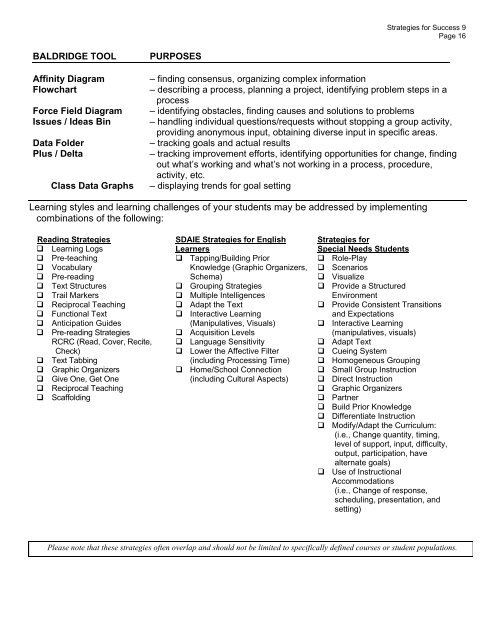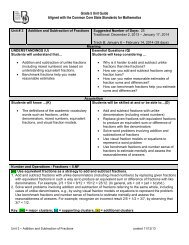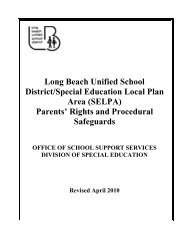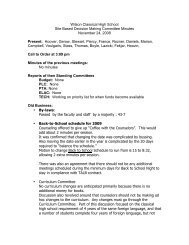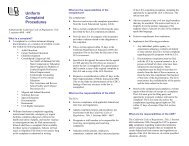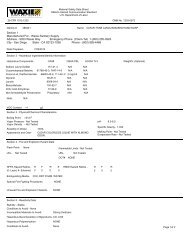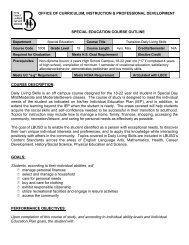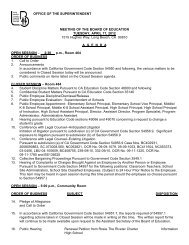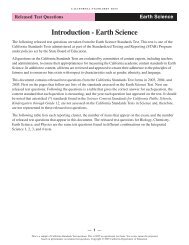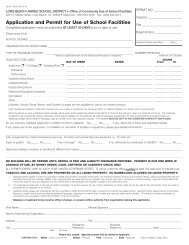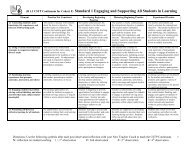high school course outline - Long Beach Unified School District
high school course outline - Long Beach Unified School District
high school course outline - Long Beach Unified School District
Create successful ePaper yourself
Turn your PDF publications into a flip-book with our unique Google optimized e-Paper software.
Strategies for Success 9<br />
Page 16<br />
BALDRIDGE TOOL<br />
Affinity Diagram<br />
Flowchart<br />
Force Field Diagram<br />
Issues / Ideas Bin<br />
Data Folder<br />
Plus / Delta<br />
Class Data Graphs<br />
PURPOSES<br />
– finding consensus, organizing complex information<br />
– describing a process, planning a project, identifying problem steps in a<br />
process<br />
– identifying obstacles, finding causes and solutions to problems<br />
– handling individual questions/requests without stopping a group activity,<br />
providing anonymous input, obtaining diverse input in specific areas.<br />
– tracking goals and actual results<br />
– tracking improvement efforts, identifying opportunities for change, finding<br />
out what’s working and what’s not working in a process, procedure,<br />
activity, etc.<br />
– displaying trends for goal setting<br />
Learning styles and learning challenges of your students may be addressed by implementing<br />
combinations of the following:<br />
Reading Strategies<br />
Learning Logs<br />
Pre-teaching<br />
Vocabulary<br />
Pre-reading<br />
Text Structures<br />
Trail Markers<br />
Reciprocal Teaching<br />
Functional Text<br />
<br />
<br />
Anticipation Guides<br />
Pre-reading Strategies<br />
RCRC (Read, Cover, Recite,<br />
Check)<br />
Text Tabbing<br />
Graphic Organizers<br />
Give One, Get One<br />
Reciprocal Teaching<br />
Scaffolding<br />
SDAIE Strategies for English<br />
Learners<br />
Tapping/Building Prior<br />
Knowledge (Graphic Organizers,<br />
Schema)<br />
Grouping Strategies<br />
Multiple Intelligences<br />
Adapt the Text<br />
Interactive Learning<br />
(Manipulatives, Visuals)<br />
Acquisition Levels<br />
Language Sensitivity<br />
Lower the Affective Filter<br />
(including Processing Time)<br />
Home/<strong>School</strong> Connection<br />
(including Cultural Aspects)<br />
Strategies for<br />
Special Needs Students<br />
Role-Play<br />
Scenarios<br />
Visualize<br />
Provide a Structured<br />
Environment<br />
Provide Consistent Transitions<br />
and Expectations<br />
Interactive Learning<br />
(manipulatives, visuals)<br />
Adapt Text<br />
Cueing System<br />
Homogeneous Grouping<br />
Small Group Instruction<br />
Direct Instruction<br />
Graphic Organizers<br />
Partner<br />
Build Prior Knowledge<br />
Differentiate Instruction<br />
Modify/Adapt the Curriculum:<br />
(i.e., Change quantity, timing,<br />
level of support, input, difficulty,<br />
output, participation, have<br />
alternate goals)<br />
Use of Instructional<br />
Accommodations<br />
(i.e., Change of response,<br />
scheduling, presentation, and<br />
setting)<br />
Please note that these strategies often overlap and should not be limited to specifically defined <strong>course</strong>s or student populations.


